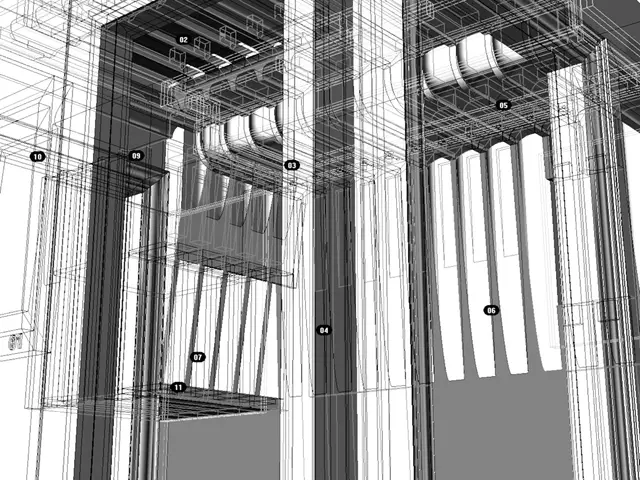Defense Spending Adjustments: Analyzing the Responses of Armaments Manufacturers amid Trump's Budget Reduction Plan
In the current political climate, market analysts predict continued volatility for defense stocks as investors grapple with unfolding policy debates. One such proposal that has raised concerns is former President Donald Trump's plan to halve the U.S. military budget.
If this proposal were to become a reality, the long-term implications for defense stocks and the defense industry would be significant and predominantly negative. Here's a breakdown of the key impacts:
- Reduced defense spending would directly cut revenues for defense contractors. Currently, over half of the Pentagon budget goes to private companies producing weapons, technology, and services. A halving of the budget would slash funds available for procurement, R&D, and contracts, adversely affecting defense firms' earnings and growth prospects.
- Potential cuts in personnel and civilian workforce could hinder military acquisition and innovation efforts. Recent budget reductions already target civilian jobs in the Air Force and Space Force, impacting research, development, and new program starts. A halved budget would exacerbate such cuts.
- Delays or cancellations of major programs like fighter jets, missile defense, shipbuilding, and advanced technologies could occur. Current budgets allocate billions for programs such as F-35 fighters, missile defense, and Navy shipbuilding, which would face major downsizing or elimination under a reduced budget scenario.
- Market valuations of defense stocks would likely fall, reflecting diminished government demand and increased uncertainty. Investors generally view defense stocks as closely tied to government defense spending; a halving would likely reduce investor confidence and stock prices.
- Long-term strategic and geopolitical risks could arise, as congressional allies express concern that cutting defense funding too deeply would jeopardize U.S. security and its ability to counter authoritarian rivals. This could lead to increased volatility and risk perceptions affecting companies in the sector.
However, some companies are expected to shift focus towards international arms sales to diversify their revenue streams. The Pentagon has expressed interest in maintaining technological superiority, which may soften the blow for certain contractors specializing in next-generation defense solutions.
The landscape for defense contractors is changing, and stakeholders must be prepared to adapt to potential transformations within the sector. Investors are advised to closely monitor legislative developments, global defense spending trends, and technological shifts within the industry.
Defense stocks experienced a downturn following Trump's proposal to halve the U.S. military budget. The selloff extended to suppliers and subcontractors that rely on Pentagon spending. Defense contractors may invest more heavily in emerging defense technologies such as artificial intelligence-driven weapons systems, autonomous drones, and cybersecurity.
Lawmakers from both parties have raised concerns about national security risks associated with drastic budget reductions. Trump's proposal is expected to face strong resistance in Congress, where defense spending has traditionally enjoyed bipartisan support. Defense contractors are evaluating cost-saving measures and lobbying efforts in response to potential budget cuts.
Traditional defense contractors may face headwinds, but companies focused on cybersecurity, space defense, and artificial intelligence in warfare could see new growth opportunities. A potential compromise could emerge, where spending reductions are less severe or are redirected towards modernizing military infrastructure rather than outright cuts.
Countries in NATO and the Indo-Pacific region may increase their defense spending due to U.S. shifting priorities, providing a potential lifeline for the sector. The S&P 500 is nearing a record high, but the factors driving the market rally are not directly related to the defense sector.
In summary, halving the U.S. military budget as proposed by Trump would drastically reduce funding flows that sustain the defense industry, causing widespread budget cuts to programs, workforce reductions, and likely a sharp contraction in defense stocks and company revenues over the long term. However, the long-term prospects for defense stocks remain more uncertain due to potential changes in military priorities and spending.
- Investors should monitor global defense spending trends, as countries in NATO and the Indo-Pacific region may increase their defense spending due to U.S. shifting priorities, potentially providing a lifeline for the sector.
- Defense contractors are evaluating cost-saving measures and lobbying efforts in response to potential budget cuts, indicating their proactive approach towards adapting to a changing landscape.
- traditional defense contractors may face headwinds, but companies focused on cybersecurity, space defense, and artificial intelligence in warfare could see new growth opportunities, highlighting the importance of investment in emerging defense technologies.
- The S&P 500 is nearing a record high, but the factors driving the market rally are not directly related to the defense sector, suggesting the need for investors to assess the sector's performance independently.




